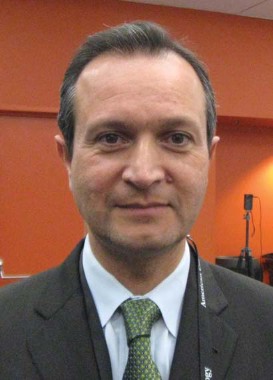User login
SAN FRANCISCO – Posttraumatic stress disorder independently increased the risk of insulin resistance by 80% and metabolic syndrome by 40% in a retrospective study of 207,954 veterans.
The incidence of insulin resistance was 14% higher and the incidence of metabolic syndrome was 12% higher in 11,420 veterans with posttraumatic stress disorder (PTSD), compared with 196,534 without PTSD, after adjusting for the effects of age, gender, ethnicity, high blood pressure, high cholesterol, family history of premature coronary artery disease, and obesity, study coleader Dr. Ramin Ebrahimi reported at the annual meeting of the American College of Cardiology.
Insulin resistance is known to increase atherogenesis and atherosclerotic plaque instability, resulting in greater risk for MI. The cluster of conditions known as metabolic syndrome (hypertension, hyperlipidemia, hyperglycemia, and abnormal cholesterol levels) has been associated with increased risk of heart disease, diabetes, and stroke.
Among veterans with PTSD, 35% had insulin resistance and 53% had metabolic syndrome, compared with 19% and 38%, respectively, in the non-PTSD group before adjusting for other factors, showing relative risk increases of roughly 80% and 40%. PTSD remained independently associated with higher rates of insulin resistance and metabolic syndrome after controlling for other risk factors, said Dr. Ebrahimi of the University of California, Los Angeles.
The investigators analyzed electronic medical records from primary care settings in the Veterans Health Administration for patients in Southern California and Nevada without known diabetes or coronary artery disease who were followed for a median of 2 years.
Although the PTSD and non-PTSD groups were similar at baseline in age, gender, lipid measures, fasting blood sugar measures, and conventional risk factors for insulin resistance and metabolic syndrome, the PTSD group developed significantly higher levels of triglycerides and fasting blood sugar, lower HDL levels, and a higher triglyceride to HDL ratio, compared with the non-PTSD group. At baseline, the veterans had a mean age of 60 years and 93% were male.
The findings may help clinicians identify and treat cardiovascular risks earlier in patients with PTSD, Dr. Ebrahimi suggested at a press conference at the meeting. Early-stage insulin resistance and metabolic syndrome can be reversed with lifestyle modifications in diet and exercise, and a more integrated approach to treating PTSD may be warranted.
The investigators now are studying the relationship of early PTSD treatment and the risk for insulin resistance and metabolic syndrome. They also are examining the effects of combined psychiatric and medical management of PTSD on the risks of metabolic disorders, MI, stroke, and death.
Whether the PTSD itself or something associated with PTSD increases the risks for insulin resistance and metabolic syndrome once PTSD is diagnosed, "these patients must be looked at a little more closely, and the risk factors in general have to be controlled a little bit more vigilantly," said Dr. Ebrahimi, who is also an interventional cardiologist in the Veterans Affairs Greater Los Angeles Healthcare System.
Nearly 8 million U.S. residents have PTSD, which is now recognized to be prevalent not only in veterans but in the broader population. "It happens when you are in an accident or have an experience that confers significant stress, health damage, or death," including rape and other traumatic events, he said.
The study defined insulin resistance as a triglyceride/HDL ratio of 3.8 or greater. Metabolic syndrome was defined by National Cholesterol Education Program Adult Treatment Program III guidelines.
Dr. Ebrahimi disclosed financial relationships with Boehringer Ingelheim, Abbott Vascular, the Medicines Company, Sanofi-Aventis, and Gilead.
*Correction 3/27/2013: An earlier version of this article included different percentages of insulin resistance and metabolic syndrome in the Major Finding section of this page.
SAN FRANCISCO – Posttraumatic stress disorder independently increased the risk of insulin resistance by 80% and metabolic syndrome by 40% in a retrospective study of 207,954 veterans.
The incidence of insulin resistance was 14% higher and the incidence of metabolic syndrome was 12% higher in 11,420 veterans with posttraumatic stress disorder (PTSD), compared with 196,534 without PTSD, after adjusting for the effects of age, gender, ethnicity, high blood pressure, high cholesterol, family history of premature coronary artery disease, and obesity, study coleader Dr. Ramin Ebrahimi reported at the annual meeting of the American College of Cardiology.
Insulin resistance is known to increase atherogenesis and atherosclerotic plaque instability, resulting in greater risk for MI. The cluster of conditions known as metabolic syndrome (hypertension, hyperlipidemia, hyperglycemia, and abnormal cholesterol levels) has been associated with increased risk of heart disease, diabetes, and stroke.
Among veterans with PTSD, 35% had insulin resistance and 53% had metabolic syndrome, compared with 19% and 38%, respectively, in the non-PTSD group before adjusting for other factors, showing relative risk increases of roughly 80% and 40%. PTSD remained independently associated with higher rates of insulin resistance and metabolic syndrome after controlling for other risk factors, said Dr. Ebrahimi of the University of California, Los Angeles.
The investigators analyzed electronic medical records from primary care settings in the Veterans Health Administration for patients in Southern California and Nevada without known diabetes or coronary artery disease who were followed for a median of 2 years.
Although the PTSD and non-PTSD groups were similar at baseline in age, gender, lipid measures, fasting blood sugar measures, and conventional risk factors for insulin resistance and metabolic syndrome, the PTSD group developed significantly higher levels of triglycerides and fasting blood sugar, lower HDL levels, and a higher triglyceride to HDL ratio, compared with the non-PTSD group. At baseline, the veterans had a mean age of 60 years and 93% were male.
The findings may help clinicians identify and treat cardiovascular risks earlier in patients with PTSD, Dr. Ebrahimi suggested at a press conference at the meeting. Early-stage insulin resistance and metabolic syndrome can be reversed with lifestyle modifications in diet and exercise, and a more integrated approach to treating PTSD may be warranted.
The investigators now are studying the relationship of early PTSD treatment and the risk for insulin resistance and metabolic syndrome. They also are examining the effects of combined psychiatric and medical management of PTSD on the risks of metabolic disorders, MI, stroke, and death.
Whether the PTSD itself or something associated with PTSD increases the risks for insulin resistance and metabolic syndrome once PTSD is diagnosed, "these patients must be looked at a little more closely, and the risk factors in general have to be controlled a little bit more vigilantly," said Dr. Ebrahimi, who is also an interventional cardiologist in the Veterans Affairs Greater Los Angeles Healthcare System.
Nearly 8 million U.S. residents have PTSD, which is now recognized to be prevalent not only in veterans but in the broader population. "It happens when you are in an accident or have an experience that confers significant stress, health damage, or death," including rape and other traumatic events, he said.
The study defined insulin resistance as a triglyceride/HDL ratio of 3.8 or greater. Metabolic syndrome was defined by National Cholesterol Education Program Adult Treatment Program III guidelines.
Dr. Ebrahimi disclosed financial relationships with Boehringer Ingelheim, Abbott Vascular, the Medicines Company, Sanofi-Aventis, and Gilead.
*Correction 3/27/2013: An earlier version of this article included different percentages of insulin resistance and metabolic syndrome in the Major Finding section of this page.
SAN FRANCISCO – Posttraumatic stress disorder independently increased the risk of insulin resistance by 80% and metabolic syndrome by 40% in a retrospective study of 207,954 veterans.
The incidence of insulin resistance was 14% higher and the incidence of metabolic syndrome was 12% higher in 11,420 veterans with posttraumatic stress disorder (PTSD), compared with 196,534 without PTSD, after adjusting for the effects of age, gender, ethnicity, high blood pressure, high cholesterol, family history of premature coronary artery disease, and obesity, study coleader Dr. Ramin Ebrahimi reported at the annual meeting of the American College of Cardiology.
Insulin resistance is known to increase atherogenesis and atherosclerotic plaque instability, resulting in greater risk for MI. The cluster of conditions known as metabolic syndrome (hypertension, hyperlipidemia, hyperglycemia, and abnormal cholesterol levels) has been associated with increased risk of heart disease, diabetes, and stroke.
Among veterans with PTSD, 35% had insulin resistance and 53% had metabolic syndrome, compared with 19% and 38%, respectively, in the non-PTSD group before adjusting for other factors, showing relative risk increases of roughly 80% and 40%. PTSD remained independently associated with higher rates of insulin resistance and metabolic syndrome after controlling for other risk factors, said Dr. Ebrahimi of the University of California, Los Angeles.
The investigators analyzed electronic medical records from primary care settings in the Veterans Health Administration for patients in Southern California and Nevada without known diabetes or coronary artery disease who were followed for a median of 2 years.
Although the PTSD and non-PTSD groups were similar at baseline in age, gender, lipid measures, fasting blood sugar measures, and conventional risk factors for insulin resistance and metabolic syndrome, the PTSD group developed significantly higher levels of triglycerides and fasting blood sugar, lower HDL levels, and a higher triglyceride to HDL ratio, compared with the non-PTSD group. At baseline, the veterans had a mean age of 60 years and 93% were male.
The findings may help clinicians identify and treat cardiovascular risks earlier in patients with PTSD, Dr. Ebrahimi suggested at a press conference at the meeting. Early-stage insulin resistance and metabolic syndrome can be reversed with lifestyle modifications in diet and exercise, and a more integrated approach to treating PTSD may be warranted.
The investigators now are studying the relationship of early PTSD treatment and the risk for insulin resistance and metabolic syndrome. They also are examining the effects of combined psychiatric and medical management of PTSD on the risks of metabolic disorders, MI, stroke, and death.
Whether the PTSD itself or something associated with PTSD increases the risks for insulin resistance and metabolic syndrome once PTSD is diagnosed, "these patients must be looked at a little more closely, and the risk factors in general have to be controlled a little bit more vigilantly," said Dr. Ebrahimi, who is also an interventional cardiologist in the Veterans Affairs Greater Los Angeles Healthcare System.
Nearly 8 million U.S. residents have PTSD, which is now recognized to be prevalent not only in veterans but in the broader population. "It happens when you are in an accident or have an experience that confers significant stress, health damage, or death," including rape and other traumatic events, he said.
The study defined insulin resistance as a triglyceride/HDL ratio of 3.8 or greater. Metabolic syndrome was defined by National Cholesterol Education Program Adult Treatment Program III guidelines.
Dr. Ebrahimi disclosed financial relationships with Boehringer Ingelheim, Abbott Vascular, the Medicines Company, Sanofi-Aventis, and Gilead.
*Correction 3/27/2013: An earlier version of this article included different percentages of insulin resistance and metabolic syndrome in the Major Finding section of this page.
AT ACC 13
Major finding: *The incidence of insulin resistance was 14% higher and the incidence of metabolic syndrome was 12% higher in patients with PTSD, compared with those without PTSD.
Data source: Retrospective study of 207,954 veterans in two states.
Disclosures: Dr. Ebrahimi disclosed financial relationships with Boehringer Ingelheim, Abbott Vascular, the Medicines Company, Sanofi-Aventis, and Gilead.

